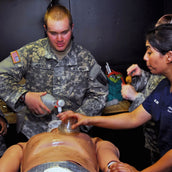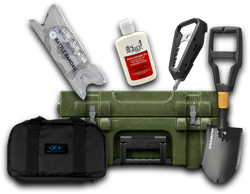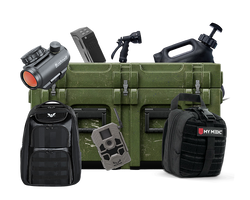
10 Tips For Flying With A Firearm
Traveling with a firearm, especially by plane, can be a stressful experience for many gun owners. There are specific protocols and rules that you need to follow. But, even when you respect them down to a "t", you still feel anxious and uncomfortable.
The problem is that the TSA staff may notice your nervousness and interpret it as suspicious or potentially dangerous behavior. From then on, they may refuse you boarding and start a procedure that could get you in a whole lot of legal problems, even if you are entirely innocent and have good intentions. You don't want to trust what people on social media are saying about flying with firearms, but do extensive research from trustworthy sites.
If you want to avoid any problems the next time you travel, it would be a good idea for you to consider these 10 tips for flying with firearms!

1. Do Your Due Diligence
Before you even buy the flight tickets, make sure that the destination you are heading to have precise regulations about firearms. Study them, and ensure that you are abiding by the legal framework regarding firearms and ammunition of the state you are visiting.
Laws regarding concealed carry or open carry laws, permits, firearm storage, use of force, and deadly force differ from one state to the other. Make sure that you are well aware and respect them throughout your stay there. If you have any doubts, you can always seek legal advice to have a crystal-clear understanding.
2. Organize Your Connections
When traveling with firearms by plane, you should try your best to get onto a non-stop flight. This way, you reduce all the hassle that comes with flying with guns.
However, if you have to change two or more flights to reach your destination, you should plan your connections with maximum attention. Make sure that you have plenty of extra time between your flights to deal with the TSA regulations and other unexpected delays.
3. Secure and Pack Your Firearm at Home
If you wait until you get to the airport to secure the firearm, you will enter a very stressful situation for both you and the TSA officers around you.
Your best choice is to pack and secure the firearm at home. Remember that you must completely unload the weapon and remove any shell from the chamber, the cylinder, and the magazines.
4. Keep Your Firearms in a Lockable Hard Case
The TSA regulations specify that travelers can carry their firearms in a locked hard sided container that feature integrated a key or combination lock. You also have to ensure that your gun is safe and out of anyone’s reach during the flight by securing it in a sturdy, lockable hard sided container. Your firearm container must remained locked at all times, with the exception of when handled by a TSA officer. This is to stop your firearm from being accessed by the wrong parties. The TSA also requires that firearms are transported in checked baggage.
5. Weigh Your Gun Case and Ammunition at Home
Flight regulations demand that gun owners can air travel with a maximum weight of 50 lbs, which includes firearms, ammunition, and the hard sided case among others. Make sure that you weigh your luggage at home, and leave out everything that is unnecessary for your trip to avoid having it removed or even confiscated at the airport. Remember, your firearms must be unloaded completely.
6. Do not use TSA Locks
Never rely on the TSA locks after they inspect and clear your gun and case. The law specifies that you must remain in possession of the keys and combination of your firearm case at all times. The TSA could easily access your luggage after inspecting it. Most likely, they will never do it, but just to make sure you abide by the laws, you should always bring your locked cases when flying with a gun.
7. Check the TSA and Airline Policies Before Each Flight
If you do not fly frequently, you should double-check with the latest changes in TSA and airline policies before each flight. While they usually remain consistent for years, they are permanently subject to modifications. The last thing you may want to happen is reaching the airport and finding out that your plan for flying with a firearm is no longer compliant with the laws and regulations.
8. Check-In at the Full-Service Counter
When you reach the airport, your best choice for checking in your luggage is the full-service ticket counter, as your firearms must be transported in checked baggage. The procedure is safer, quicker, and more reliable than the curbside check-in. Here, you need to declare the firearm you are traveling with.
The standard procedure asks you to say “I declare a firearm” to the ticketing agent. Do not, under any circumstances, say “I have a gun,” which is prohibited by the regulations and might cause you all kinds of trouble.
From the full-service counter, you will go with a TSA agent to a secure room where your gun container and firearm will undergo a full inspection.
9. Stay By Your Luggage During Screening
From the secure room, the TSA will place your luggage in line to pass the security scanners. At this point, you should remain with your bag throughout the entire process. A simple case of miscommunication between the TSA staff could set you back a few steps and have to undergo another inspection. You will want to avoid this kind of mishaps that could delay you and even make you lose your flight.
10.Have Documents for Everything
Flying with a firearm is easy and comfortable if you plan it thoroughly ahead and have the necessary documents for every step of your itinerary.
Make sure that you print the policies for the airline and for the airports that you will pass through during your travels. Also, have a copy of the TSA policy for traveling with firearms. Have printed pictures of your guns, gun carrier, and the ammunition you carry.
Remember that it is legal and even recommended to record or photograph your firearms and suitcase before, during, and after the inspection. Take pictures of your gun and gun case before and after closing it every time it leaves your possession.
You will rarely need these documents and pictures. However, if something goes wrong during the inspection or while you travel, they will be extremely valuable during a potential lawsuit.
Last but not least, remember to have a good and responsible attitude when flying with guns. The TSA agents are not there to make your trip a bad experience, even if sometimes, the security process is an unbearable hassle. They are just doing their job and ensuring that everyone's traveling experience is safe and that the laws and regulations in place are thoroughly respected.
Image from AmmoToGo.com
Share this article








